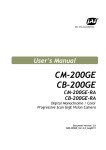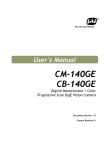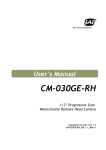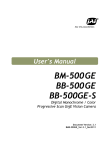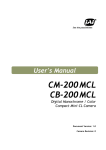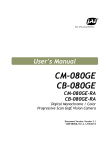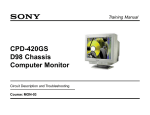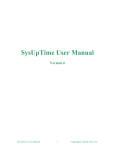Download CM-200GE CB-200GE
Transcript
-0- Preliminary Version Subject to changes User's Manual CM-200GE CB-200GE Digital Monochrome / Color Progressive Scan GigE Vision Camera Document Version: First Draft Camera Revision: 0 CM-200 GE / CB-200 GE Table of Contents 1. General ............................................................................................................ - 3 2. Camera nomenclature ........................................................................................... - 4 3. Main Features ..................................................................................................... - 4 4. Locations and Functions......................................................................................... - 5 5. Pin Assignment ................................................................................................... - 6 5.1. 12-pin Multi-connector (DC-in/GPIO/Iris Video) ..................................................... - 6 5.2. Digital Output Connector for Gigabit Ethernet....................................................... - 6 6. GPIO (Inputs and outputs )..................................................................................... - 7 6.1. Overview................................................................................................... - 7 6.1.1. LUT ( Look Up Table) ............................................................................. - 7 6.1.2. 12-bit Counter ..................................................................................... - 8 6.1.3. Pulse Generators .................................................................................. - 8 6.2. Optical Interface ......................................................................................... - 8 6.2.1 Recommended External Input circuit diagram for customer ............................... - 8 6.2.2 Recommended External Output circuit diagram for customer ............................. - 9 6.2.3 Optical Interface Specifications ................................................................. - 9 6.3. Inputs and outputs table ............................................................................. - 10 6.4. Configuring the GPIO module (register settings) ................................................... - 10 6.4.1. Input/Output Signal Selector................................................................... - 10 6.4.2. 12bit counter ..................................................................................... - 11 6.4.3. Pulse generators (20 bit x 4) ................................................................... - 11 6.5. GPIO programming examples.......................................................................... - 13 6.5.1 GPIO Plus PWC shutter .......................................................................... - 13 6.5.2 Internal Trigger Generator ....................................................................... - 14 7. GigE Vision Streaming Protocol (GVSP) ..................................................................... - 15 7.1. Digital Video Output (Bit Allocation)................................................................. - 15 7.2. Bit Allocation (Pixel Format / Pixel Type) – CM-200GE ........................................... - 15 7.2.1. GVSP_PIX_MONO8 (8bit) ........................................................................ - 15 7.2.2. GVSP_PIX_MONO10 (10bit) ..................................................................... - 15 7.2.3. GVSP_PIX_MONO10_PACKED ( 10 bit ) ........................................................ - 16 7.3. Bit Allocation (Pixel Format / Pixel Type) – CB-200GE ............................................ - 16 7.3.3 GVSP_PIX_BAYRG8 “ BayreRG8 “ ............................................................... - 16 7.3.4 GVSP_PIX_BAYRG10 “Bayer RG10” .............................................................. - 16 7.3.1 GVSP_PIX_BAYGB8 “BayerGB8” .................................................................. - 16 7.3.2 GVSP_PIX_BAYGB10 “ BayerGB10” .............................................................. - 17 8. Functions and Operations ...................................................................................... - 18 8.1. GigE Vision Standard Interface......................................................................... - 18 8.2. Recommended Network Configurations .............................................................. - 18 8.2.1 Verified Network Interface Cards (NICs) ....................................................... - 18 8.2.2 Video data rate (network bandwidth) .......................................................... - 19 8.2.3 How to set Jumbo Frame........................................................................ - 19 8.2.4 Packet delay ...................................................................................... - 21 8.2.5 Filter Driver Installation ......................................................................... - 22 8.3. Basic functions ........................................................................................... - 23 8.3.1 Vertical Binning (CM-200GE only). ........................................................... - 23 8.3.2 CB-200GE. Bayer filter ........................................................................... - 23 8.3.3 Electronic Shutter................................................................................. - 24 8.3.4. Auto Iris Lens video output (12-pin Hirose connector) ..................................... - 25 8.3.5 Auto-detect LVAL-sync / a-sync. accumulation .............................................. - 25 8.3.6 Rear panel indicator. ............................................................................ - 26 8.4. Sensor Layout and timing .............................................................................. - 26 8.4.1. CCD Sensor Layout ................................................................................ - 26 8.4.2. Horizontal timing ................................................................................. - 27 8.4.3. Vertical timing..................................................................................... - 27 8.4.4. Partial Scanning ................................................................................... - 28 - -1- CM-200 GE / CB-200 GE 8.4.5. Vertical binning ................................................................................... - 29 8.5. Operation Modes ......................................................................................... - 30 8.5.1 Continuous operation ............................................................................ - 30 8.5.2 Edge Pre-select Trigger Mode .................................................................. - 31 8.5.3 Pulse Width Control Trigger Mode ............................................................. - 32 8.5.4 Sequential Trigger Mode ( EPS)................................................................ - 34 8.5.5 Delayed Readout Mode ( EPS ) ................................................................. - 35 8.5.6 OB transfer Mode.................................................................................. - 36 8.6. Operation Mode and Functions matrix ............................................................... - 37 9. Camera Control Tool........................................................................................... - 37 10. Register Map.................................................................................................... - 40 11. External Appearance and Dimensions ...................................................................... - 51 12. Specifications.................................................................................................. - 52 12.1. Spectral response ...................................................................................... - 52 12.2. Specification table..................................................................................... - 53 13. Appendix ........................................................................................................ - 55 Precautions ..................................................................................................... - 55 Typical Sensor Characteristics ............................................................................... - 55 References ...................................................................................................... - 55 13. User's Record............................................................................................... - 59 - -2- CM-200 GE / CB-200 GE 1. General This manual covers the digital monochrome progressive scan camera CM-200GE and color progressive scan camera CB-200GE The CM-200GE/CB-200GE is a GigE Vision compliant camera, based on the CM-200MCL/CB-200MCL. Both the monochrome version CM-200GE and the color version CB-200GE provide a frame rate of 25 frames/second at full resolution. Using vertical binning (CM-200GE only) and partial scan provides higher frame rates. The 1/1.8" CCD with square pixels offers a superb image quality. The high-speed shutter function and asynchronous random trigger mode allows the camera to capture high quality images of fast moving objects. The color version CB-200GE, based on CCD sensor with primary RGB Bayer mosaic filter, outputs raw Bayer images. Host-based color interpolation is required to display or save color images. The CM-200GE/CB-200GE also complies with the GenICam standards, as it has in internal XML file that is used to describe the functions/features of the camera. For further information on GenICam please go to www.emva.org. As an application programming interface, JAI provides an SDK (Software Development Kit). This SDK includes GigE Vision Filter Driver, JAI Control tool, software documentation and code examples. The JAI SDK can be downloaded from www.jai.com. Important Note: GigE Vision Filter Driver should be installed on this stage. The latest version of this manual can be downloaded from www.jai.com For camera revision history, please contact your local JAI distributor. -3- CM-200 GE / CB-200 GE 2. Camera nomenclature The standard camera composition consists of the camera main body and C-mount protection cap. The camera is available in the following versions: CM-200GE Where C stands for "Compact" family, M stands for "Monochrome", 200 represents the resolution "2.0 million pixel" and GE stands for " GigE Vision " interface CB-200GE Where C stands for "Compact" family, B stands for "Bayer mosaic color", 200 represents the resolution "2.0 million pixel" and GE stands for " GigE Vision" interface 3. Main Features • • • • • • • • • • • • • • • Member of Compact series, covering VGA to UXGA resolution 1624 (h) x 1236 (v) 4.4 µm square pixels 1/1.8” progressive scan – Monochrome and Bayer mosaic color versions 25 frames/second with full resolution in continuous operation 24 frames/second with external trigger and full resolution Increased frame rate with vertical binning (CM-200GE only) and partial scan Exposure time from 32μs to 2 sec. using Pulse Width Control trigger mode Programmable exposure from 64μs to 40 ms in Full Frame scan Sequencer trigger mode for on-the –fly change of gain, exposure and ROI Edge Pre-select and Pulse width trigger mode LVAL-synchronous/-asynchronous operation (auto-detect) Auto iris lens video output allows a wider range of light (Can be Selected by DIP switch ) GigE Vision Interface with 10 or 8-bit output Programmable GPIO with opto-isolated inputs and outputs Comprehensive software tools and SDK for Windows XP/Vista -4- CM-200 GE / CB-200 GE FCC seal 4. Locations and Functions ④ ③ GigE ⑧ POWER/ TRIG ② 1 2 3 4 5 h i j Lens mount CCD sensor 12-pin connector RJ-45 LED LED LED Mounting holes Serial No. ⑦ Caution seal ① C-mount (Note *1) 1/1.8 inch CCD sensor DC +12V power and GPIO interface Gigabit Ethernet connector Indication for power and trigger input GigE Network condition : LINK GigE Network condition : ACT M3 depth 4mm for tripod mount plate *1) Note: Rear protrusion on C-mount lens must be less than 10.0mm. Fig. 1. Locations -5- ⑥ ⑤ CM-200 GE / CB-200 GE 5. Pin Assignment 5.1. 12-pin Multi-connector (DC-in/GPIO/Iris Video) Type: HR10A-10R-12PB (Hirose) male. (Seen from rear of camera.) 9 1 2 8 10 11 3 4 7 12 5 6 Fig. 2. 12-pin connector. Pin no. Signal Remarks 1 GND 2 +12 V DC input 3 Opt IN 2 (-) / GND (*1) 4 Opt IN 2 (+)/Iris Video out (*1) 5 Opt IN 1 ( - ) 6 Opt IN 1 ( + ) GPIO IN / OUT 7 Opt Out 1 ( - ) 8 Opt Out 1 ( + ) 9 Opt Out 2 ( - ) 10 Opt Out 2 ( + ) 11 + 12 V DC input 12 GND *1 : Iris Video output function can be set by the internal DIP switch. The internal DIP switch SW600 is set at the right side as factory default. To set it at the left, the iris video output is activated. 5.2. Digital Output Connector for Gigabit Ethernet Type: RJ-45 HFJ11-1G02E-L21RL or equivalent 8 7 6 54 3 2 1 Fig. 3. Gigabit Ethernet connector The digital output signals follow the Gigabit Ethernet interface using RJ-45 conforming connector. The following is pin assignment for Gigabit Ethernet connector. Pin No 1 2 3 4 5 6 7 8 In/Out In/Out In/Out In/Out In/Out In/Out In/Out In/Out In/Out Name MX1+ (DA+) MX1- (DA-) MX2+ (DB+) MX3+ (DC+) MX3- (DC-) MX2- (DB-) MX4+ (DD+) MX4- (DD-) -6- CM-200 GE / CB-200 GE 6. GPIO (Inputs and outputs ) 6.1. Overview All input and output signals pass through the GPIO (General Purpose Input and Output) module. The GPIO module consists of a Look-Up Table (LUT – Cross-Point Switch), 4 Pulse Generators and a 12-bit counter. In the LUT, the relationship between inputs, counters and outputs is governed by internal register set-up. On the above block diagram, Trigger 0 is used for Exposure and Trigger 1 is used for Delayed Readout. The Time Stamp Reset can reset the time stamp complied with GigE Vision standard. This is used for having the same time stamp in case of using multiple cameras. The blocks shown in the above diagram have the following functionality: 6.1.1. LUT ( Look Up Table) The LUT works as a cross-point switch which allows connecting inputs and outputs freely. The signals LVAL_IN, DVAL_IN, FVAL_IN and EEN_IN all originate from the camera timing circuit. On this diagram, Trigger 0 is one for exposure and Trigger 1 is for Delayed Readout. The Time Stamp Reset signal can reset the time stamp specified in GigE Vision Format. This signal can be used when time stamps from several cameras connected are coincident with each other. -7- CM-200 GE / CB-200 GE 6.1.2. 12-bit Counter A 25MHz clock or the camera pixel clock ( 65MHz) can be used as a source. The counter has a “Divide by N”, where N has the range 1 through 4096, allowing a wide range of clock frequencies to be programmed. Setting Value 0 is bypass, setting value 1 is 1/2 dividing and setting value 4095 is 1/4096 dividing. 6.1.3. Pulse Generators (0 to 3) Each pulse generator consists of a 20bit counter. The behavior of these signals is defined by their pulse width, start point and end point. The pulse generator signals can be set in either triggered or periodic mode. In triggered mode, the pulse is triggered by the rising edge/falling edge/high level or low level of the input signal. In periodic mode, the trigger continuously generates a signal that is based on the configured pulse width, starting point and end point. Each pulse generator operates at the frequency created in the 12 bit counter. Accordingly, if 25MHz is used as the main frequency, the frequency of pulse generator is from 25NHz to 6.104KHz and if the pixel clock (65NHz) is used as the main frequency , the frequency of pulse generator is 65NHz to 15.869KHz. 6.2. Optical Interface The new series of JAI GigE Vision camera implements optical interface for GPIO input and output by using photo coupler device. The photo coupler device has light emitting diode and photo transistor inside in general . The electronic signal is converted to the light in the light emitting diode and the light conducts photo transistor . Fig.4. Photo coupler The input and the output are electrically isolated and the different reference voltages can be used for the external input and output circuit. CM-200GE and CB-200GE can accept DC+3.3V to DC+24V for the external input circuit and DC+5V to DC+24V for the external output circuit. 6.2.1 Recommended External Input circuit diagram for customer EXTERNAL INPUT User side Camera Inside hirose-12 c onnector Pin 4 and 6 2k2 Us er Power +3.3V to +24V 10kB 1 2 3 To camera circuit hirose-12 c onnector Pin 3 and 5 2 3 82 Fig.5 To +3.3V External Input Circuit -8- CM-200 GE / CB-200 GE 6.2.2 Recommended External Output circuit diagram for customer EXTERNAL OUTPUT User side Camera Inside hirose-12 connector Pin 8 and 10 User Power +5V to +24V To +12V 2 From Camera Circuit OUT 270 hirose-12 connector Pin 7 and 9 220 Fig.6. External Output Circuit 6.2.3 Optical Interface Specifications The relation of the Input signal and the output signal through optical interface is as follows. Time Delay Rise Rise Time Time Delay Fall Fall Time TDR (us) RT (us) TDF (us) FT (us) User Power(VCC) 5V 12V 0.54 0.62 1.2 2.0 1.5 2.4 3.4 4.5 3.3V 0.54 1.2 1.5 3.6 Fig.7. Optical Interface Performance -9- 24V 0.68 3.0 2.1 6.8 CM-200 GE / CB-200 GE 6.3. Inputs and outputs table Output Port LVAL IN DVAL IN FVAL IN EEN IN OPT IN 1 Input Port OPT IN 2 Soft Trigger 0 Soft Trigger 1 Soft Trigger 2 Soft Trigger 3 Pulse Generator 0 Pulse Generator 1 Pulse Generator 2 Pulse Generator 3 OPT OUT1 OPT OUT2 Time Stamp Reset × × × × ○ ○ ○ ○ ○ ○ ○ × × × ○ ○ ○ ○ ○ ○ ○ ○ × × × ○ ○ ○ ○ ○ ○ ○ ○ ○ ○ ○ ○ ○ ○ ○ Trigger 0 Trigger 1 × × × × ○ ○ ○ ○ ○ ○ ○ Pulse Generato r0 Pulse Generato r1 Pulse Generato r2 Pulse Generato r3 × × × × ○ ○ ○ ○ ○ ○ ○ ○ ○ ○ ○ ○ ○ ○ ○ ○ ○ × ○ ○ ○ ○ ○ ○ ○ ○ ○ ○ ○ ○ ○ ○ ○ ○ ○ ○ ○ ○ ○ ○ ○ ○ ○ ○ ○ ○ ○ ○ ○ ○ ○ ○ ○ ○ × ○ ○ ○ ○ ○ ○ ○ × ○ ○ ○ ○ ○ ○ ○ × 6.4. Configuring the GPIO module (register settings) 6.4.1. Input/Output Signal Selector Address 0xB060 0xB064 Internal Name Selector CAMERA TRIGGER 0 ( for Camera Trigger ) Selector CAMERA Trigger 1 ( For Delayed Trigger ) GenIcam Name Camera Trigger 0 Camera Trigger 1 0xB070 Selector GPIO PORT 1 ( Optical Out 1 ) GPIO_Port1 0xB074 Selector GPIO PORT 2 ( Optical Out 2 ) GPIO_Port2 0xB090 Pulse Generator 0 Selector 0xB094 Pulse Generator 1 Selector 0xB098 Pulse Generator 2 Selector 0xB09C Pulse Generator 3 Selector 0xB0A0 Selector Time Stamp Reset PulseGenerator0 PulseGenerator1 PulseGenerator2 PulseGenerator3 TimeStampReset - 10 - Access Size R/W 4 R/W 4 R/W 4 R/W 4 R/W 4 R/W 4 R/W 4 R/W 4 R/W 4 Value (Range) GPIO Selector: 0x00:CAMERA LVAL IN 0x01:CAMERA DVAL IN 0x02:CAMERA FVAL IN 0x03:CAMERA EEN IN 0x04:GPIO Port 1 IN 0x05:GPIO Port 2 IN 0x0C:SOFT TRIG 0 0x0D:SOFT TRIG 1 0x0E:SOFT TRIG 2 0x0F:SOFT TRIG 3 0x10:Pulse Generator 0 0x11: Pulse Generator 1 0x12: Pulse Generator 2 0x13: Pulse Generator 13 0x7F:No Connect Add 0x80 will result in low active output. CM-200 GE / CB-200 GE 6.4.2. 12bit counter Address Internal Name 0xB000 Counter Clock Choice GenIcam Name ClockSource Access Size R/W 4 R/W 4 ClockPreScaler 0xB004 Counter Dividing Value Value (Range) 0x00: 25MHz 0x01: Pixel Clock 0x000: Bypass 0x001: 1/2 Dividing 0x002: 1/3 Dividing | 0xFFF: 1/4096 Dividing 6.4.3. Pulse generators (20 bit x 4) There are 4 pulse generators (designated 0 through 3) that can be used to create various timing scenarios by programming start point, endpoint, length and repeats. Start Point End Point Length These settings can be done with JAI Control tool which is included in the JAI SDK. The created pulse has the raising edge on the starting point and the falling edge on the ending point as described on the above. Accordingly, the HIGH period is ( the starting point – the ending point ) x 1/( the pulse generator frequency) For instance, Main frequency Pixel clock ( 65MHz) 12 bit counter Bypass Starting point 100 Ending point 750 And then, the pulse generator frequency is 65MHz. The pulse width is ( 750-100) x 1/65000000 = 10µs When the starting point needs to be delayed, the starting value is given by “n”. The delay value is calculated by n x 1/( the pulse generator frequency ). The above case , n is 100. n=0 means no delay. The length should be 1 clock longer than the ending point if the pulse generator creates one pulse for the external trigger. When the repeat operation is used, the repeating interval is set by N x 1/( the pulse generator frequency). In this case, it is also necessary to set the value at 1 clock longer than the ending point. - 11 - CM-200 GE / CB-200 GE Address 0xB008 0xB00C Internal Name Length Counter 0 Start point Counter 0(1) 0xB010 GenIcam name Access R/W R/W Size 4 4 Start point Counter 0(2) R/W 4 0xB014 End point Counter 0 R/W 4 0xB018 Counter Clear 0 R/W 4 0xB01C 0xB020 Length Counter 1 Start point Counter 1(1) R/W R/W 4 4 0xB024 Start point Counter 1(2) R/W 4 0xB028 End point Counter 1 R/W 4 0xB02C Counter 1 Clear R/W 4 0xB030 0xB034 Length Counter 2 Start point Counter 2(1) R/W R/W 4 4 0xB038 Start point Counter 2(2) R/W 4 0xB03C Address End point Counter 2 Internal Name R/W Access 4 Size 0xB040 Counter 2 Clear R/W 4 0xB044 0xB048 Length Counter 3 Start point Counter 3(1) R/W R/W 4 4 0xB04C Start point Counter 3(2) R/W 4 0xB050 End point Counter 3 R/W 4 0xB054 Counter 3 Clear R/W 4 GenIcam name - 12 - Value (range) 0x00001 to 0xFFFFF 0x00000 to 0xFFFFF 0x00: infinite 0x01: 1 time | 0xFF: 255 times 0x00001 to 0xFFFFF 0x00: Free Run 0x01: High Level Clear 0x02: Low Level Clear 0x04: Rising Edge Clear 0x08: Falling Edge Clear 0x00001 to 0xFFFFF 0x00000 to 0xFFFFF 0: Infinite 1: 1 time | 255: 255 times 0x00001 to 0xFFFFF 0x00: Free Run 0x01: High Level Clear 0x02: Low Level Clear 0x04: Rising Edge Clear 0x08: Falling Edge Clear 0x00001 to 0xFFFFF 0x00000 to 0xFFFFF 0x00: Infinite 0x01: 1 time | 0xFF: 255 times 0x00001 to 0xFFFFF Value (range) 0x00: Free Run 0x01: High Level Clear 0x02: Low Level Clear 0x04: Rising Edge Clear 0x08: Falling Edge Clear 0x00001 to 0xFFFFF 0x00000 to 0xFFFFF 0x00: Infinite 0x01: 1 time | 0xFF: 255 times 0x00001 to 0xFFFFF 0x00: Free Run 0x01: High Level Clear 0x02: Low Level Clear 0x04: Rising Edge Clear 0x08: Falling Edge Clear CM-200 GE / CB-200 GE 6.5. GPIO programming examples 6.5.1 GPIO Plus PWC shutter Example: 10µs unit pulse width exposure control (PWC). Pixel clock is 65MHz. 650 clocks (750-100) equals 10µs. Address 0xA040 0xB000 0xB004 0xB008 0xB00C 0xB010 0xB014 0xB018 0xB060 0xB090 Register Trigger Mode Clock Choice Counter Dividing Value Length Counter 0 Start point Counter 0 Repeat Count 0 End point Counter 0 Counter Clear 0 CAMERA TRIGGER Selector Pulse Generator 0 Selector LVAL IN DVAL IN FVAL IN EEN IN Trigger 0 Trigger 1 LUT OPT IN 1 OPT IN 2 Soft Trigger 0 Soft Trigger 1 Soft Trigger 2 Soft Trigger 3 OPT OUT 1 OPT OUT 2 (Cross point switch) ( Cross Point Switch ) Pulse Generator 3 (20bit Counter) Pulse Generator 2 (20bit Counter) Pulse Generator 1 (20bit Counter) Pulse Generator 0 (20bit Counter) 25 MHz Pixel Clock Value 2 = PWC ( Pulse Width Control) 1 = Pixel Clock ( 65 MHz ) 0 = Pass through 1000 Clocks 100 Clocks 1 750 Clocks 4 = Rising Edge Clear 11 = pulse generator 0 4 =OPT IN 1 12bit 12bit Counter Counte OPT IN 1 Pulse Generator 0 output 100 750 Fig.8. Pulse Generator Timing Example 1 1000 - 13 - Time Stamp Reset CM-200 GE / CB-200 GE 6.5.2 Internal Trigger Generator Create a trigger signal and trigger the camera Register Trigger Mode Clock Choice Counter Dividing Value Length Counter 0 Start point Counter 0 Repeat Count 0 End point Counter 0 Counter Clear 0 CAMERA TRIGGER Selector Address 0xA040 0xB000 0xB004 0xB008 0xB00C 0xB010 0xB014 0xB018 0xB058 Value 1 = EPS 1 = Pixel Clock 2079 = 1/2080 dev(Line Rate) 1000 Clocks 100 Clocks 0 = Free Run 500 Clocks 0 = No Clear 11 = pulse generator 0 LVAL IN DVAL IN FVAL IN EEN IN Trigger 0 Trigger 1 LUT OPT IN 1 OPT IN 2 Soft Trigger 0 Soft Trigger 1 Soft Trigger 2 Soft Trigger 3 (Cross point switch) ( Cross Point Switch ) Pulse Generator 3 (20bit Counter) Pulse Generator 2 (20bit Counter) Pulse Generator 1 (20bit Counter) Pulse Generator 0 (20bit Counter) 25 MHz Pixel Clock(65MHz) 12bit 12bit Counter Counte Line Rate 32.696KHz P u lse Gen er a t or 0 ou t pu t 100 Line 500 Line 1000 Line Fig.9. Pulse Generator 0 timing Example 2 - 14 - OPT OUT 1 OPT OUT 2 Time Stamp Reset CM-200 GE / CB-200 GE 7. GigE Vision Streaming Protocol (GVSP) 7.1. Digital Video Output (Bit Allocation) Although the CM-200GE and CB-200GE are digital cameras, the image is generated by an analog component, the CCD sensor. The table and diagram below show the relationship between the analog CCD output level and the digital output. CCD out Black 200mV 230mV Analog Signal * Setup 3.6%, 25mV 700mV 800mV Digital Out(10-bit) 32LSB 890LSB 1023LSB The standard setting for 10-bit video level is 890 LSB. 200 mV CCD output level equals 100% video output. 1023 Wh i te C l ip Leve l 890 D ig i ta l Ou t [LSB ] 100% Leve l 32 0 B lack Leve l 25 Ana log S igna l mV [ ] 700 800 Fig. 10. Digital Output 7.2. Bit Allocation (Pixel Format / Pixel Type) – CM-200GE In the GigE Vision Interface, GVSP(GigE Vision Streaming Protocol) is used for an application layer protocol relying on the UDP transport layer protocol. It allows an application to receive image data, image information and other information from a device. In CM-200GE, the following pixel types supported by GVSP are available. With regard to the details of GVSP, please refer GigE Vision Specification available from AIA (www.machinevisiononline.org). 7.2.1. GVSP_PIX_MONO8 (8bit) 1Byte 2Byte 3Byte Y0 Y1 Y2 0 1 2 3 4 5 6 7 0 1 2 3 4 5 6 7 0 1 2 3 4 5 6 7 7.2.2. GVSP_PIX_MONO10 (10bit) 1Byte 2Byte 3Byte 4Byte Y0 Y0 Y1 Y1 0 1 2 3 4 5 6 7 8 9 X X X X X X 0 1 2 3 4 5 6 7 8 9 X X X X X X - 15 - CM-200 GE / CB-200 GE 7.2.3. GVSP_PIX_MONO10_PACKED ( 10 bit ) Y0 Y1 Y2 Y3 2 3 4 5 6 7 8 9 0 1 X X 0 1 X X 2 3 4 5 6 7 8 9 2 3 4 5 6 7 8 9 0 1 X X 0 1 X X 2 3 4 5 6 7 8 9 Address 0xA410 Internal Name Access Size R/W 4 Pixel Format type Value 0x01080001:Mono8 0x01100003:Mono10 0x010C0004:Mono10 Packed 7.3. Bit Allocation (Pixel Format / Pixel Type) – CB-200GE In the GigE Vision Interface, GVSP(GigE Vision Streaming Protocol) is used for an application layer protocol relying on the UDP transport layer protocol. It allows an application to receive image data, image information and other information from a device. In CB-200GE, the following pixel types supported by GVSP are available. With regard to the details of GVSP, please refer GigE Vision Specification available from AIA. 7.3.3 GVSP_PIX_BAYRG8 “ BayreRG8 “ Odd Line 1 Byte 2 Byte 3 Byte R0 G1 R2 0 1 2 3 4 5 6 7 0 1 2 3 4 5 6 7 0 1 2 3 4 5 6 7 Even Line G0 B1 G2 0 1 2 3 4 5 6 7 0 1 2 3 4 5 6 7 0 1 2 3 4 5 6 7 7.3.4 GVSP_PIX_BAYRG10 “Bayer RG10” Odd Line 1 Byte 2 Byte 3 Byte 4 Byte R0 R0 G1 G1 0 1 2 3 4 5 6 7 8 9 X X X X X X 0 1 2 3 4 5 6 7 8 9 X X X X X X Even Line G0 G0 B1 B1 0 1 2 3 4 5 6 7 8 9 X X X X X X 0 1 2 3 4 5 6 7 8 9 X X X X X X 7.3.1 GVSP_PIX_BAYGB8 “BayerGB8” Odd Line G0 B1 G2 0 1 2 3 4 5 6 7 0 1 2 3 4 5 6 7 0 1 2 3 4 5 6 7 Even Line R0 G1 R2 0 1 2 3 4 5 6 7 0 1 2 3 4 5 6 7 0 1 2 3 4 5 6 7 - 16 - CM-200 GE / CB-200 GE 7.3.2 GVSP_PIX_BAYGB10 “ BayerGB10” Odd Line 1 Byte 2 Byte 3 Byte 4 Byte G0 G0 B1 B1 0 1 2 3 4 5 6 7 8 9 X X X X X X 0 1 2 3 4 5 6 7 8 9 X X X X X X Even Line R0 R0 G1 G1 0 1 2 3 4 5 6 7 8 9 X X X X X X 0 1 2 3 4 5 6 7 8 9 X X X X X X Address 0xA410 Internal Name Pixel Format type Access Size R/W 4 Value 0x01080009:BAYRG8 0x0108000A: BAYGB8 0x0110000D:BAYRG10 0x0110000E:BAYGB10 Note: CB-200GE has the same Bayer sequence for Full and any of partial scanning as RG. Therefore, comparing full scanning and partial scanning, the center might be shifted. As the Pixel Format type, CB-200GE supports BAYER GB 8 and BAYER GB 10. When this type is selected , the output starts from 2nd line for all scanning. - 17 - CM-200 GE / CB-200 GE 8. Functions and Operations 8.1. GigE Vision Standard Interface The CM-200GE and CB-200GE are designed in accordance with the GigE Vision standard. In transmits digital images over Cat5e or Cat6 Ethernet cables. All camera functions are also controlled via the GigE Vision interface. The camera can operate in continuous mode, providing an endless stream of images. For capturing individual images, related to a specific event, the camera can also be trigged. For precise triggering, it is recommended to use a hardware trigger applied to the Hirose 12-pin connector. It is also possible to initiate a software trigger through the GigE Vision interface. However, when using software trigger, certain latency inherent to the GigE interface must be anticipated. This latency, that manifests itself as jitter, greatly depends on the general conditions and traffic on the GigE connection. The frame rate described in this manual is for the ideal case and may deteriorate depending on conditions. When using multiple cameras (going through a switch and/or a single path) or when operating in a system with limited transmission bandwidth the Delayed Readout Mode and Inter-Packet Delay functions can be useful. 8.2. Recommended Network Configurations Although the CM-200GE and CB-200GE conform to Gigabit Ethernet (IEEE 802.3) not all combinations of network interface cards (NICs) and Switches/Routers are suitable for use with the GigE Vision compliant camera. JAI will endeavor to continuously verify these combinations, in order to give users the widest choice of GigE components for their system design. 8.2.1 Verified Network Interface Cards (NICs) At the time of publishing this document these combinations have been verified: NIC manufacturer Intel Intel Intel Model PRO/1000MT (PWLA8490MT) PRO/1000GT (PWLA8391GT) PRO/1000PT (EXPI9300PT) PCI Bus PCI-X Bus PCI-Express Bus √ (33MHz) √(100MHz) − √ (33MHz) √ (33MHz) − − − √ ( x1 ) Minimum PC requirements are as follows in order to fulfill the above conditions: ♦ Intel Core 2 Duo , 2.4GHz or better, alternatively AMD Athlon 64 x2, CPU ♦ At least 2 GB memory ♦ Video Card with PCI Express Bus x 16 , VRAM better than DDR2 with 256 MB or more, and display capability of 2560 x 1600 ♦ More than 200 GB free disk space ♦ Windows XP, SP2 (32bit) ♦ 20 inch or larger ( 24 inch recommended ) Display monitor ♦ Functions such as Screen saver and Power save should not be used. Unnecessary applications such as Word, Excel or others should not be used. Pentium 4 type PC is not recommended due to dependency on chip set bus performance. - 18 - CM-200 GE / CB-200 GE 8.2.2 Video data rate (network bandwidth) The video bit rate for CM-200GE and CB-200GE is: Model Pixel Type CM-200GE CB-200GE MONO8 MONO10_PACKED MONO10 BAYRG8,BAYGB8 BAYRG10,BAYBG10 Packet data volume (In case the Packet size is 1500) 416Mbit/s 624Mbit/s 832Mbit/s 416Mbit/s 832Mbit/s ♦ In case using Jumbo Frame, the packet data will be improved 2 %. ♦ For CM-200GE and CB-200GE, the jumbo frame can be set at maximum 4040 Bytes ( Factory setting is 1440 Byte ). To set Jumbo Frame, refer chapter 8.2.3. ♦ When OB transfer mode is used, the maximum packet value is 867Mbit/s. To ensure the integrity of packets transmitted from the camera is recommended to follow these simple guidelines: 1. Whenever possible use a peer-to-peer network. 2. When connecting several cameras, going though a network switch, make sure it is capable of handling jumbo packets and that it has sufficient memory capacity. 3. Configure inter-packet delay to avoid congestion in networks switches. 4. Disable screen saver and power save functions on computers. 5. Use high performance computers with multi-CPU, hyper-thread and 64-bit CPU, etc. 6. Only used Gigabit Ethernet equipment and components together with the camera. 7. Use at least Cat5e or preferably Cat6 Ethernet cables. 8. Whenever possible, limit the camera output to 8-bit. 8.2.3 How to set Jumbo Frame (1) Click [start] and click [Control Panel]. (2)Click [Performance and Maintenance]. (3)Click [System]. (4)Click [Hardware] tab. (5)Click [Device Manager]. - 19 - CM-200 GE / CB-200 GE (6)Expand [Network adapters]. (7) Select target NIC, right-click, and click [Properties]. Note: The following procedure is the case you use Intel(R)1000. Accordingly the procedure is different if you use different NIC appeared on Network Adaptors. In that case, set the item of a similar content described here.. (8)Click [Advanced] tab. - 20 - CM-200 GE / CB-200 GE (9) Select Jumbo Frames of Property, and select 9014 of Value. (10)Click [OK]. (11)Close [Device Manager]. (12)Close [System Properties] clicking [OK]. 8.2.4 Packet delay Packet Delay is one of GigE Vision functionalities. This function controls the data bandwidth through network. When the delay value increases, the reliability of transmission is improved but on the other hand , the transfer rate will be decreased. This is set depending on the network conditions. Packet Delay (Duration of each packet) Packet Packet This is set in the camera control tool. ( The picture is shown in the example of CB-140GE) - 21 - CM-200 GE / CB-200 GE 8.2.5 Filter Driver Installation For GigE Vision camera connection, it is recommended to use GigE Vision Filter Driver provided in the JAI SDK in order to maximize the performance the camera. Click to Install GigE Vision Filter Driver . When the installation is completed and the camera is connected, the JAI Camera Control tool shows the Filter Driver as the network Interface. If Socket Driver is used, click settings button and open the setting menu. The driver can be changed . - 22 - CM-200 GE / CB-200 GE 8.3. Basic functions The CM-200GE and CB-200GE cameras are progressive scan cameras with 10 or 8 bit video output in Gigabit Ethernet. The camera has 1/2, 1/4 or 1/8 partial scanning for faster frame rates. Vertical binning is also available. The camera can operate in continuous mode as well as in 5 triggered modes: - Edge pre-select(EPS) - Pulse width control(PWC) - Sequential trigger ( EPS ) - Delayed readout ( EPS ) The accumulation can be LVAL synchronous or LVAL a-synchronous. In the following section the functions are described in detail. An analogue iris video signal ( DIP switch select )can be used for lens iris control. 8.3.1 Vertical Binning (CM-200GE only). The binning functions can be used to achieve higher frame rate or higher sensitivity. The drawback is lower resolution. Vertical binning is done by adding the charge from pixels in adjacent lines in the horizontal CCD register. H Xsg1 No V binning V binning Video out 1 clk h F Fig.11. CM-200GE binning. Fig. 11 shows the binning principle. Resolution and frame rate for all combinations are shown in the below table. The CM-140GE has ON or OFF function for Vertical Binning: Setting Value for Register Resolution address 0xA084 Off (no binning) 0x01 1624(h) x 1236(v) pixels 2:1 binning 0x02 1624(h) x 618(v) pixels 8.3.2 CB-200GE. Bayer filter CB-200GE is a color camera based on a CCD sensor with a Bayer RGB color mosaic. The color image reconstruction is done in the host PC. The Color sequence in the video signal is the same for all scanning formats. The line readout follows LVAL. The first valid pixel is the same timing as DVAL. The Bayer color sequence starts with: GBG for even line numbers. RGR for odd line numbers. Fig.12. Bayer layout for each scanning - 23 - Frame rate 24.98 frames/sec. 44.49 frames /sec. CM-200 GE / CB-200 GE 8.3.3 Electronic Shutter CM-200GE / CB-200GE has conventional shutter functions as well as the GenICam standard “Exposure Time Abs” function. Preset Shutter 10 steps preset shutter are available: OFF (1/31); 1/60, 1/100; 1/250; 1/500; 1/1,000; 1/2,000; 1/4,000; 1/8,000; 1/10,000 sec. (See the register map included in the SDK documentation for details how to configure this register - 0xA004) Programmable Shutter It is possible to set the shutter speed in the range of 2L to 1251L by 1L unit, in case of Full Frame operation. When 1251L is set, it is the equivalent of “OFF (1/25)“ or 40.032ms. (See the register map included in the SDK documentation for details how to configure this register - 0xA008) Normal V Binning Minimum Shutter Time 2L 32µs(1L) * 2L = 64µs 35.846µs * 2L = 71.692µs Maximum Shutter Time 32µs * 1251L≈ 1 Frame(40.032ms) 35.846µs * 627L ≈ 22.475ms Pulse Width Control With this mode selected the exposure time is controlled by the width of the trigger pulse. The minimum trigger pulse width is equal to 1L (32µs) Exposure Time Abs (GenICam Standard) This is a function specified in the GenICam standard. The shutter speed can be entered as an absolute exposure time in microseconds (μs) in register address 0xA018. The entered absolute time (Time Abs) is then converted to programmable exposure (PE) value inside the camera. The below calculating formula shows the relationship between the PE value used by the camera for the different readout modes and the value entered in register 0xA018. Due to round down figure, some errors may be occurred. The relation between PE value and Time Abs. Normal readout PE= 2 + INT ( Exposure time -64) µs / (2080/65000000) V Binning readout PE= 2 + INT ( Exposure time -71.692) µs / (2330/65000000) INT means round down . The following table shows minimum value and maximum value for each readout mode. Normal Scan 2/3 Partial Scan 1/2 Partial Scan 1/4 Partial Scan 1/8 Partial Scan V-Binning Scan Minimum value 64us 64us 64us 64us 64us 71.692us Maximum Value 40.032ms 28.512ms 22.816ms 14.386ms 10.208ms 22.476ms GPIO plus PWC More precise exposure time can be obtained by using GPIO and PWC trigger mode simultaneously. As for the setting example, refer to chapter 6.5.1. - 24 - CM-200 GE / CB-200 GE 8.3.4. Auto Iris Lens video output (12-pin Hirose connector) Video Output 75 This analogue signal is not routed through the GPIO. This signal is available at pin 4 of 12-pin Hirose connector. It can be used for lens iris control in Continuous mode only. The signal is taken from the CCD sensor output before the gain circuit. The video output is without sync. The signal is 0.7 Vpp from <400 Ω AC coupled. 10k GND Fig. 13. Video output circuit. To get this signal, the internal DIP switch must be set as follows. 930 100% Leve l Ana log Ou t mV [ ] 700 The internal DIP switch SW600 is set at the right side as factory default. To set it at the left, the iris video output is activated. 0 CCD Ou t mV [ ] 200 265 Fig. 14. Iris video output. 8.3.5 Auto-detect LVAL-sync / a-sync. accumulation This function replaces the manual setting found in older JAI cameras. Whether accumulation is synchronous or a-synchronous in relationship to LVAL depends on the timing of the trigger input. When trigger is received while FVAL is high (during readout), the camera works in LVAL-synchronous mode, preventing reset feed trough in the video signal. There is a maximum jitter of one LVAL period from issuing a trigger and accumulation start. When trigger is received when FVAL is low, the cameras works in LVAL-asynchronous mode (no delay) mode. This applies to both pre-select (PS) trigger mode and pulse width trigger (PW) mode. Ext. trigger (1) (2) (3) FVAL (1) In this period camera executes trigger at next LVAL (prevents feed-through noise) (2) Avoid trigger at FVAL transition (+/- 1 LVAL period), as the function may randomly switch between "next LVAL" and "immediate". (3) In this period camera executes trigger immediately (no delay) Fig. 15. Auto-detect LVAL sync /a-sync accumulation - 25 - CM-200 GE / CB-200 GE 8.3.6 Rear panel indicator. The rear panel mounted LED provides the following information: Amber: Power connected - initiating Steady green: Camera is operating in Continuous mode Flashing green. The camera is receiving external trigger The indication on Ethernet connector is: Steady green: Connecting in 1000Base-T : LINK Flashing green: Connecting in except 1000Base-T : LINK Flashing amber: In active : ACT GigE POWER/ TRIG Fig.16. Rear Panel 8.4. Sensor Layout and timing 8.4.1. CCD Sensor Layout The CCD sensor layout with respect to pixels and lines used in the timing and video full frame read out is shown below. Fig. 17. CCD sensor layout Important Note: In GigE Vision, only Active Pixel Area is output through the GigE interface. However, CM-200GE and CB-200GE equip with “ OB transfer mode, 16 pixels for horizontal and 12 lines for vertical for OB in full scan mode are transferred, if this mode is used. - 26 - CM-200 GE / CB-200 GE 8.4.2. Horizontal timing The LVAL period is shown for normal continuous mode. Horizontal Video Timing Full Frame Read out / Partial Read Out 1 LVAL 2080 clk = 32 μs 1 clk = 15.38 ns LVAL DATA OUT 12 clk Valid data OB OB OB 48 clk 1628 clk 392 clk 1688 clk 1640 clk DVAL 1624 clk 16 clk 4 clk 32 clk Fig. 18. Horizontal timing 8.4.3. Vertical timing The FVAL period for normal continuous mode full scan is shown. Vertical Video Timing Full Frame Read out Frame rate : 1251L 24.98fps LVAL FVAL 1 2 3 1234 1235 1236 DVAL 3L DATA 10L OB 1236L Valid data CCD Exposure EEN XEEN Fig. 19. Vertical timing for full scan - 27 - 2L OB OB CM-200 GE / CB-200 GE 8.4.4. Partial Scanning The FVAL period is shown for 1/2 partial scan in normal continuous mode. 1 line = 26.7 μs Vertical Timing The below diagram and table provide vertical timing information for the fixed partial scan settings 1/2, 1/4, 1/3 and 2/3 Partial Frame Readout LVAL FVAL DVAL 3L Valid data DATA CCD Exposure EEN XEEN A C B Values for vertical timing in partial scan continuous mode. AREA FVAL Low (L) A (L) 1/2 3 48 1/4 3 70 1/8 3 81 2/3 3 33 B (L) Start line End line 616 311 926 308 465 772 156 541 696 824 207 1030 C (L) Total line (L) frame rate (fps) 46L 713L 43.82 68L 449L 69.59 79L 319L 97.96 31L 891L 35.07 Fig. 20. Vertical timing for partial scanning - 28 - CM-200 GE / CB-200 GE Horizontal Timing The horizontal timing is the same the full scanning. Horizontal Video Timing Full Frame Read out / Partial Read Out 1 LVAL 2080 clk = 32 μs 1 clk = 15.38 ns LVAL DATA OUT 12 clk OB Valid data OB OB 48 clk 1628 clk 392 clk 1688 clk 1640 clk DVAL 1624 clk 32 clk 16 clk 4 clk Fig.21. Horizontal Timing for Partial Scanning 8.4.5. Vertical binning Vertical binning combines charge from two adjacent lines, reducing the vertical resolution to half and at the same time increasing frame rate and sensitivity. By activating this function, the frame rate is increased to 44.492 fps. This function is available only for CM-200GE. Important Note Vertical Binning can not be used together with the Partial Scanning. Horizontal Timing Horizontal Video Timing V Binning 1 LVAL 2330 clk = 35.846 μs 1 clk = 15.38 ns LVAL DATA OUT OB 12 clk Valid data OB 1628 clk 48 clk 1688 clk OB 642 clk 1640 clk DVAL 1624 clk 4 clk 16 clk Fig.22. Horizontal Timing for Vertical Binning - 29 - 32 clk CM-200 GE / CB-200 GE Vertical timing Vertical Video Timing V Binning Frame rate : 627L 44.492 fps LVAL FVAL 1+2 3+4 1233+1234 1235+1236 DVAL 3L DATA 5L 618L 1L Valid data OB OB OB CCD Exposure EEN XEEN Fig.23. Vertical Timing for Vertical Binning 8.5. Operation Modes This camera can operate in 6 primary modes. 1. Continuous Mode 2. Edge Pre-select Mode (EPS) 3. Pulse Width Control Mode (PWC) 4. Sequential Trigger 5. Delayed Readout Trigger Pre-selected exposure. Pre-selected exposure. Pulse width controlled exposure. Pre-selected exposure (EPS ) Pre-selected exposure (EPS ) 8.5.1 Continuous operation For applications not requiring asynchronous external trigger, but where a continuous stream of images is required, this mode should be used. In this mode it possible to use a lens with video controlled iris. For timing details, refer to fig. 18. through fig. 23. To use this mode: Set function: Trigger mode Continuous Scanning Vertical binning Shutter mode Shutter speed Programmable exposure - 30 - Full, Partial scanning On/Off (CM-200GE only) Preset, Programmable, Auto CM-200 GE / CB-200 GE 8.5.2 Edge Pre-select Trigger Mode An external trigger pulse initiates the capture, and the exposure time (accumulation time) is the fixed shutter speed set by registers. The accumulation can be LVAL synchronous or LVAL a-synchronous. The resulting video signal will start to be read out after the selected shutter time. For timing details, refer to fig. 18. through fig. 25. To use this mode: Set function: Trigger mode EPS Scanning Vertical binning Shutter mode Shutter speed Programmable exposure Accumulation Other functions and settings Ext. trigger. Input: Full, Partial ON / OFF Preset, Programmable LVAL Sync / LVAL a-sync GigE interface or 12-pin Hirose Important notes on using this mode Trigger pulse >1 LVAL to <1 FVAL) The following table shows minimum trigger interval in synchronous accumulation mode 1055 L Full scan 1/2 Partial 821 L 2/3 partial 705 L 1/4 Partial 531 L 1/8 Partial 445 L 1/2 V Binning 530 L In case of a-synchronous mode, the exposure time should be added to the above table. LVAL_sync timing Trig 2L(min.) LVAL 1L(max) CCD Exposure EEN Exposure XEEN FVAL Trigger input whthin FVAL HIGH Period LVAL SYNC Mode Setting Fig. 24. Edge Pre-select LVAL sync Timing - 31 - 2L CM-200 GE / CB-200 GE LVAL_a-sync timing 5.37 μs ± 1μs Trig 1L(min.) CCD exposure EEN XEEN Exposure time FVAL Trigger input during FVAL LOW period LVAL a-SYNC mode setting 2L to 3L Fig.25. Edge Pre-select LVAL a-sync Timing 8.5.3 Pulse Width Control Trigger Mode In this mode the accumulation time is equal the trigger pulse width. Here it is possible to have long time exposure. The maximum recommended time is <2 seconds. The accumulation can be LVAL synchronous or LVAL a-synchronous. The resulting video signal will start to be read out after the trigger rising edge. For timing details, refer to fig. 18. through fig. 23 and fig. 26 and 27. To use this mode: Set function: Input: Trigger mode PWC Scanning Vertical binning Accumulation Other functions and settings Ext. trigger. Full , Partial ON / OFF LVAL sync / LVAL a-sync GigE interface or 12-pin Hirose Important notes on using this mode Trigger pulse width >1 LVAL to <2 seconds The following table shows minimum trigger interval in synchronous accumulation mode 1055 L Full scan 1/2 Partial 821 L 2/3 Partial 705 L 1/4 Partial 531 L 1/8 Partial 445 L V Binning 530 L In case of a-synchronous mode, the exposure time should be added to the above table. - 32 - CM-200 GE / CB-200 GE LVAL_sync timing Trig 1L(Min.) LVAL 1L to 2L 1L(Max) CCD Exposure EEN XEEN Exposure FVAL Trigger input whthin FVAL HIGH Period LVAL SYNC Mode Setting 2L Fig. 26. Pulse width control. LVAL sync. LVAL_a-sync timing 5.37 μs ± 1 μs Trig 1L 1L(Min.) CCD exposure EEN XEEN Exposure FVAL Trigger input during FVAL LOW period LVAL a-SYNC mode setting Fig.27. Pulse Width control LVAL a-sync - 33 - 2L to 3L CM-200 GE / CB-200 GE 8.5.4 Sequential Trigger Mode ( EPS) The ROI, Shutter and Gain values can be preset up to 10 sequences. Along with every trigger input, the image data with the preset sequence is output as described below. Trigger Sequence Operation Sequence 1 Sequence 2 Sequence 3 Sequence 4 Signals added to trigger can be selected by 0xB060 Camera Trigger Selector on register map via GPIO. The camera will functions on the rising edge of the trigger and Negative or Positive should be determined accordingly. For the sequence, the following default settings are installed. ID 1 2 3 4 5 6 7 8 9 10 Width 1624 1624 1624 1624 1624 1624 1624 1624 1624 1624 ROI Offset Height X 1236 0 1236 0 1236 0 1236 0 1236 0 1236 0 1236 0 1236 0 1236 0 1236 0 Offset Y 0 0 0 0 0 0 0 0 0 0 Shutter Gain 1251 1251 1251 1251 1251 1251 1251 1251 1251 1251 0 0 0 0 0 0 0 0 0 0 The following registers are used to configure the sequence. 0xC0F4 0xC0F8 0xA30C 0xB060 0xA040 Sequence Repetitions (Number of Repetitions) Sequence Ending Position (Ending Position) Sequence Reset Command ( 1 only ) Selection for camera trigger 0 Trigger mode selection and 0x09 for Sequential EPS mode Example of settings Setting : Repeat 5 times from ID 1 through ID 8 0xC0F4 0xC0F8 0xB060 0xA040 0xA3F0 0xA040 Set to 0x05 Set to 0x08 For instance, 12p #6 for Optical IN 1 Sequential EPS(9). Set this for start Set Normal Mode(0) for stop Please refer the detailed register description on Camera Register Map which is included in the SDK . The following table shows the minimum trigger interval in synchronous accumulation mode. In case of a-synchronous accumulation mode, the exposure time should be added to figures in this table. Full Scan 1/2 Partial 2/3 Partial 1/4 Partial 1/8 Partial 1/2 V Binning 1052 L 818 L 702 L 528 L 442 L 527 L - 34 - CM-200 GE / CB-200 GE ♦ The conditions for this table is that shutter speed should be set the same for all sequences. If the shutter speed is different , the difference of exposure time should be added. ♦ It is recommended to set the exposure time in the order from the shortest to the longer one. ♦ The minimum trigger interval is > ( Exposure time ( L ) + FVAL on Normal scan ( 1248L) + 1L ♦ Do not input the trigger just after the sequence is reset. It requires at least 500ms delay. 8.5.5 Delayed Readout Mode ( EPS ) This mode can be used to delay the transmission of a captured image. When several cameras are triggered simultaneously and connected to the same GigE interface, it allows the cameras to be read out in sequence, preventing congestion. The image data is not transmitted directly by the trigger 0 and it is stored in the memory located at Ethernet Interface. By the falling edge of the soft trigger 1, the image data is output. Example of setting 0xA040 0xB060 0xB-064 EPS Delayed Readout (0x11) Trigger 0 select, e.g. 0x04 OPT IN 1 Trigger 1 select, e.g. 0x05 OPT IN 2 For the details of Registers, please refer Camera Register Map which is included in the SDK. - 35 - CM-200 GE / CB-200 GE 8.5.6 OB transfer Mode On this mode, the OB part is also transmitted. OB part can be used for black reference in the frame grabber board. This can be set by register 0xA41C for ON or OFF. OB Transfer Mode OFF Normal Scan 1 1 OB Transfer Mode ON 1624 1 1 10 1236 2/3 Partial Scan 1 1 1624 1640 16 pixels for Horizontal, & 12 lines for Vertical are added. 1246 1248 1624 1 1 1624 1640 ます 824 824 16 pixels for Horizontal is added 1/2 Partial Scan 1 1 1624 1 1 616 1624 1640 16 pixels for horizontal is added. 616 1/4 Partial Scan 1 1 1624 1 1 1624 1640 ます 308 308 16 pixels for horizontal is added. 1/8 Partial Scan 1 1 1624 1 1 156 1624 1640 16 pixels for horizontal is added. 156 V Binning Scan 1 1 1624 1 1 1624 1640 ます 618 618 - 36 - 16 pixels for horizontal is added. CM-200 GE / CB-200 GE 8.6. Operation Mode and Functions matrix ID (Value) Note 1 0x00 0x01 0x02 0x09 0x11 Mode Shutter Preset / Program. Vertical Binning Note 2 Partial Scanning LVAL Sync/Async Auto Iris output Yes Yes Yes --- Yes ( Note 3) Yes Yes Auto No Yes Yes Yes Yes a-sync only No Yes Yes Auto No Continuous Edge Pre-select Yes (EPS) Pulse Width Control Not applicable (PWC) Sequential Edge Pre-select Yes (EPS) EPS Delayed Yes Readout Auto No Note 1: Write ID in register address 0xA040 in order to set trigger mode. Note 2: Vertical Binning is available for only CM-200GE. Note 3: The Auto iris output is only effective on Normal scan and Vertical binning modes. 9. Camera Control Tool The picture represents CM-140GE as the reference. JAI SDK provides the Camera Control Toll for JAI GigE Vision Camera. The followings are several hints to use this Control Tool. ♦ After start JAI Control Tool and connect the camera , the following control menu will be activate. - 37 - CM-200 GE / CB-200 GE ♦ After click Feature Properties, and extend each item, the following control menu will be activate. ♦ For setting, each item should be active and change the value or select the necessary item. The following example is the Shutter setting. ♦ In case of value setting, slide the setting bar or write directly the value. ♦ - 38 - CM-200 GE / CB-200 GE ♦ For capturing the image, click “ Start Acquisition “ . ♦ When the image size is changed , the image capturing must be stopped by clicking “ Stop Acquisition”. It is possible to change shutter and gain values while capturing the image. ♦ When capturing , if the frame rate is decreasing, check the packet size. The packet size varies as depending on the Network conditions, set at the most appropriate value. The range of the packet size for CM-200GE and CB-200GE is from 1428 to 4040 and the factory default setting is 1428. Please note that the setting packet size is not memorized and therefore, it is necessary to set on every power up. For the further details, please refer JAI Control Tool Document provided with JAI SDK. - 39 - CM-200 GE / CB-200 GE 10. Register Map The below table provides detailed information for the hardware registers used for controlling the camera and obtaining information on the status of the camera. The content of this register map is also found in the XML file, as stipulated by the GenICam standard. Read / Write Generic Registers: Function 0x0000 Version R 4 0x0004 Device mode R 4 R 4 R 4 0x0008 0x000c Device MAC address (high) Device MAC address (low) Size Address Value / Range of value (Major, Minor) vector 0x0010 IP R 4 Bit 0: persistent Bit 1: DHCP Bit 2: LLA 0x0014 IP address setup R / W 4 Bit 0: persistent Bit 1: DHCP Bit 2: LLA 0x0024 0x0034 Current IP address Current subnet mask Current default gateway R R 4 4 R 4 0x0044 Description Version of the GigE Standard to which the device is compliant. Information about device mode of operation. Upper 4 bytes of the MAC address Lower 4 bytes of the MAC address Bits can be OR-ed. All other bits are reserved and set to 0. DHCP and LLA bits must be on. Bits can be OR-ed. LLA is always activated and is read only. 0x0048 Manufacturer's name R 32 e.g. JAI 0x0068 Model name R 32 e.g. CM-200GE 0x0088 Device version R 32 0x00A8 Manufacturer specific info R 80 0x00D8 Serial number R 16 0x00E8 Camera ID R / W 16 User assignable string 0x0200 First choice of URL for XML R 512 File extension .XML indicates uncompressed text file. File extension .ZIP indicates compressed using ZIP. Provides extended manufacturer information about the device. Camera serial number 0x0400 Second choice of URL for XML R 512 0x0600 Number of network interfaces R 4 Indicates the number of physical network interfaces on this device. 0x064C persistent IP address R / W 4 Valid if Persistent IP is enabled - 40 - Default value CM-200 GE / CB-200 GE R / W R / W persistent subnet mask 0x066C persistent gateway Address Function 0x0900 number of messaging channels R 4 This camera has 1 0x0904 number of stream channels R 4 This camera only has 1 4 Valid if Persistent IP is enabled 4 Valid if Persistent IP is enabled Size Read / Write 0x065C Value / Range of value 0x0934 GVCP capability R 4 Bit 31:multiple read Bit 30:WRITEMEM Bit29: ACKETRESEND Bit 28:EVENT Bit 27:EVENTDATA 0x0938 Heartbeat timeout R / W 4 The min. value is 500 ms 0x093C Timestamp tick frequency (High) R 4 Timestamp tick frequency is 0 if timestamp is not supported. 0x0940 Timestamp tick frequency (Low) R 4 0x0944 Timestamp control W 4 0x0948 Timestamp (High) R 4 0x094C Timestamp (Low) R 4 0x0a00 CCP 0x0b00 MCP 0x0b10 MCDA 0x0b14 MCTT 0x0b18 MCRC 0x0d00 SCP0 R R / W R / W R / W R / W R W 4 Bit 0: Reset Bit 1:latch current timestamp 0:Disconnect 1:Exclusive 2:Control 3:Exclusive Control 4 4 Not specified Description Default value number of available message channel number of available stream channel This is a capability register indicating which one of the non-mandatory GVCP commands are supported by this device. In milliseconds. Internally, the heartbeat is rounded according to the clock used for heartbeat. 64-bit value indicating the number of timestamp clock ticks in 1 second. This register holds the most significant bytes. This register holds the least significant bytes. Used to latch the current timestamp value. No need to clear to 0. Latched value of the timestamp (most significant bytes) Latched value of the timestamp (least significant bytes) 0 control channel privilege register 0 message channel port register 0 message channel destination address register 4 message channel transfer timeout: ms 300 4 message channel retry count 2 4 Not specified - 41 - primary stream port register CM-200 GE / CB-200 GE 0x0d04 SCPS0 0x0d08 SCPD0 0x0d18 SCDA0 R / W R / W R / W 4 4 4 Decided by system 32us Max With 62.5MHz Tick Time Not specified Decided by application - 42 - primary stream channel packet size register packet size includes IP, UDP&GVSP Header 1440 XML file primary stream channel packet delay register 0 primary stream channel destination address register CM-200 GE / CB-200 GE Function 0xA000 Shutter mode R / W 0xA004 Preset shutter R / W 0xA008 Programmable exposure, PE R / W 0xA018 Exposure TimeAbs ( single) R / W Size Address Read / Write Standard camera functions registers: 4 4 4 4 0xA040 Trigger Mode R / W 4 0xA080 Partial Scan R / W 4 0xA084 Vertical Binning 0xA0C4 Manual Gain Level 0xA0E0 User Black level 0xA13C Test Stream (Jumbo Packet Check) R / W R / W R / W R / W Value / Range of value 0= Preset shutter 1= Programmable exposure 4=Exposure TimeAbs 0=Off; 1=1/60; 2=1/100; 3=1/250; 4=1/500; 5=1/1000; 6=1/2000; 7=1/4000; 8=1/8000; 9=1/10000; Description Sets exposure time for image capture. Fixed values for setting exposure 2 to 1251( OFF) Flexible setting of exposure time ranging from 64 µs to 40.032 ms using the LVAL period (L) as increment. 1L is 32us. 64 to 40032 ( OFF) Actual exposure time in microseconds, µs. The camera will round value off to match LVAL increments. 0x00=Continuous 0x01=Edge preselect 0x02=Pulse width control 0x09=Sequential EPS 0x11=Delayed EPS 0=Full Frame 1=2/3 Partial 2=1/2 Partial 3=1/4 Partial 4=1/8 Partial Default value 0 0 1251 40032 0 0 4 1=Binning OFF 2=1/2 V Binning 1 4 -84 to 336 0 4 4 0 to 1023 64 LSB=1023 32LSB=512 to 528 CM-200GE 0=OFF 1=White Noise 4=H Ramp Scale 5=V Ramp Scale 6=Moving Ramp Scale CB-200GE 0=OFF - 43 - 525 0 0 CM-200 GE / CB-200 GE 1= White Noise 4=H Ramp Scale 5=V Ramp Scale 6=Moving Ramp Scale 8=Color Bar 9=Color Bar 10=Moving Color Bar 0xA300 Save Settings into User area W 4 0xA304 Load Settings W 4 0xA308 EPROM current Area No. R 4 0xA30C Save Sequence W 4 1=User area1 2=User area2 3=User area3 0=Factory area 1=User area1 2=User area2 3=User area3 Allows use to save all camera settings. Last used area number becomes new default. 1 Allow the user to recall all camera settings. 0 0 0 to 3 1 1 only Function Sequence Shutter 1 0xC000 Sequence Shutter 2 0xC004 Sequence Shutter 3 0xC008 Sequence Shutter 4 0xC00C Sequence Shutter 5 0xC010 Sequence Shutter 6 0xC014 Sequence Shutter 7 0xC018 Sequence Shutter 8 0xC01C Sequence Shutter 9 0xC020 Sequence Shutter 10 0xC024 0xC078 Sequence Gain 1 R / W R / W R / W R / W R / W R / W R / W R / W R / W R / W R / W Value / Range of value Description Default value 4 2 to 1251 Pre-program 1st shutter value 1251 4 2 to 1251 Pre-program 2nd shutter value 1251 4 2 to 1251 Pre-program 3rd shutter value 1251 4 2 to 1251 Pre-program 4th shutter value 1251 4 2 to 1251 Pre-program 5th shutter value 1251 4 2 to 1251 Pre-program 6th shutter value 1251 4 2 to 1251 Pre-program 7th shutter value 1251 4 2 to 1251 Pre-program 8th shutter value 1251 4 2 to 1251 Pre-program 9th shutter value 1251 4 2 to 1251 Pre-program 10th shutter value 1251 4 -84 to 326 Pre-program 1st Gain value 0 Size Address Read / Write Sequence function registers: - 44 - CM-200 GE / CB-200 GE 0xC07C Sequence Gain 2 0xC080 Sequence Gain 3 0xC084 Sequence Gain 4 0xC088 Sequence Gain 5 0xC08C Sequence Gain 6 0xC090 Sequence Gain 7 0xC094 Sequence Gain 8 0xC098 Sequence Gain 9 0xC09C Sequence Gain 10 0xC0F0 Sequence Reset 0xC0F4 Sequence Mode Function 1 0xC0F8 Sequence Mode Function 2 0xC0FC Sequence ROI size- X1 0xC100 Sequence ROI Size- X2 0xC104 Sequence ROI Size- X3 0xC108 Sequence ROI Size- X 4 0xC10C Sequence ROI size- X5 0xC110 Sequence ROI Size- X 6 0xC114 Sequence ROI size- X7 0xC118 Sequence ROI Size- X8 0xC11C Sequence ROI size- X9 R / W R / W R / W R / W R / W R / W R / W R / W R / W W R / W R / W R / W R / W R / W R / W R / W R / W R / W R / W R / 4 4 4 -84 to 326 Pre-program 2nd Gain value 0 4 -84 to 326 Pre-program 3rd Gain value 0 4 -84 to 326 Pre-program 4th Gain value 0 4 -84 to 326 Pre-program 5th Gain value 0 4 -84 to 326 Pre-program 6th Gain value 0 4 -84 to 326 Pre-program 7th Gain value 0 4 -84 to 326 Pre-program 8th Gain value 0 4 -84 to 326 Pre-program 9th Gain value 0 4 -84 to 326 Pre-program 10th Gain value 0 4 1 only 4 0 to 255 Number of repetition 0 0 to 10 Ending position 1 Sequence Reset 8 to 1392 1 Width max 4 8 to 1392 Width max 4 8 to 1392 Width max 4 8 to 1392 Width max 4 8 to 1392 Width max 4 8 to 1392 Width max 4 8 to 1392 Width max 4 8 to 1392 Width max 4 8 to 1392 Width max - 45 - CM-200 GE / CB-200 GE W 0xC120 Sequence ROI Size- X10 0xC124 Sequence ROI Size-Y1 0xC128 Sequence ROI Size-Y2 0xC12C Sequence ROI Size-Y3 0xC130 Sequence ROI Size-Y4 0xC134 Sequence ROI Size-Y5 0xC138 Sequence ROI Size-Y6 0xC13C Sequence ROI Size-Y7 0xC140 Sequence ROI Size-Y8 0xC144 Sequence ROI Size-Y9 0xC148 Sequence ROI Size-Y10 0xC14C Sequence ROI Offset-X1 0xC150 Sequence ROI Offset-X2 0xC154 Sequence ROI Offset-X3 0XC158 Sequence ROI Offset-X4 0xC15C Sequence ROI Offset-X5 0xC160 Sequence ROI Offset-X6 0xC164 Sequence ROI Offset-X7 0xC168 Sequence ROI Offset-X8 0xC16C Sequence ROI Offset-X9 R / W R / W R / W R / W R / W R / W R / W R / W R / W R / W R / W R / W R / W R / W R / W R / W R / W R / W R / W R / 4 8 to 1392 Width max 8 to 1040 Height Max 4 4 8 to 1040 Height Max 4 8 to 1040 Height Max 4 8 to 1040 Height Max 4 8 to 1040 Height Max 4 8 to 1040 Height Max 4 8 to 1040 Height Max 4 8 to 1040 Height Max 4 8 to 1040 Height Max 4 8 to 1040 Height Max 4 0 to 1384 0 4 0 to 1384 0 4 0 to 1384 0 4 0 to 1384 0 4 0 to 1384 0 4 0 to 1384 0 4 0 to 1384 0 4 0 to 1384 0 4 0 to 1384 - 46 - 0 CM-200 GE / CB-200 GE W 0xC170 Sequence ROI Offset-X10 0xC174 Sequence ROI Offset-Y1 0xC178 Sequence ROI Offset-Y2 0xC17C Sequence ROI Offset-Y3 0xC180 Sequence ROI Offset-Y4 0xC184 Sequence ROI Offset-Y5 0xC188 Sequence ROI Offset-Y6 0xC18C Sequence ROI Offset-Y7 0xC190 Sequence ROI Offset-Y8 0xC194 Sequence ROI Offset-Y9 0xC198 Sequence ROI Offset-Y10 R / W R / W R / W R / W R / W R / W R / W R / W R / W R / W R / W 4 0 to 1384 0 0 to 1032 0 4 4 0 0 to 1032 0 4 0 to 1032 4 0 0 to 1032 0 4 0 to 1032 4 0 0 to 1032 4 0 0 to 1032 4 0 0 to 1032 4 0 0 to 1032 4 0 0 to 1032 Read / Write Size GigE Vision streaming related registers: 0xA400 Horizontal Image Size R 4 0xA404 Vertical Image Size R 4 Address Function Value / Range of value 0xA410 Video Pixel Format Type R / W 4 0x01080001 0x010C0004 0x01100003 0x01080009 0x0108000A 0x0110000D 0x0110000E 0xA414 Frame Skipping Ratio R / W 4 0=STD(30fps) 1=STD/2 2=STD/4 3=STD/8 0xA418 Payload Length register 4 Number of bytes in a frame 0xA41C OB Trans Mode 4 0= OFF 1= ON R / W R / - 47 - Description return proper value when normal, V-bin & partial return proper value when normal, V-bin & partial Mono8 Mono 10 Packed Mono10 BAYRG8 BAYGB8 BAYRG10 BAYGB10 Default value Mono8 for CM200GE / BAYGB8 for CB200GE 0 0 CM-200 GE / CB-200 GE W 0xA504 ROI1 Size X 0xA508 ROI1 Size Y 0xA50C ROI1 Offset X 0xA510 ROI1 Offset Y 0xA600 Soft Trigger 0 0xA604 Video Sending Flag 0xA610 Event ON/OFF register 0xA640 Camera Reset ( from GenIcam) 0xA644 Soft Trigger 1 0XA648 Soft Trigger 2 0xA64C Soft Trigger 3 0xA714 FPGA version R / W R / W R / W R / W R / W R / W R / W w R / W R / W R / W R 4 Width W.Max 4 Height H.Max 4 0 to 1384 Horizontal offset 0 Vertical offset 0 4 0 to 1032 4 0=LOW 1=HIGH 0 4 0=Off, 1=On 0 4 4 Bit 31:GEV_EVENT_TRI GGER Bit30:GEV_EVENT_ START_OF_EXPOSU RE Bit29:GEV_EVENT_ END_OF_EXPOSURE Bit28:GEV_EVENT_ START_OF_TRANSF ER Bit27:GEV_EVENT_ END_OF_TRANSFER 0=OFF 1=Reset 0 0 0 0 0 0 4 0=LOW, 1=HIGH 0 4 0=LOW, 1=HIGH 0 4 0=LOW, 1=HIGH 0 4 - 48 - CM-200 GE / CB-200 GE GPIO Registers: Counter Clock source R / W 0xB004 Counter Divide by Value R / W 0xB008 Length Counter 0 0xB00C Start point Counter 0 (1) 0xB010 Start point Counter 0(2) 0xB014 4 0x00 0x01 25MHz Pixel Clock 0 4 0x000 0x001 0x002 | 0xFFF Bypass Divide by 2 Divide by 3 | Divide by 4096 0 4 0x00001 to 0xFFFFF Defines the length of the counter 1 4 0x00001 to 0xFFFFF Defines the starting point of the counter 0 R / W 4 0x00: infinite 0x01: 1 time | 0xFF: 255 times Defines the number of repeats (loops) 0 End point Counter 0 R / W 4 0x00001 to 0xFFFFF Defines the end point of the counter 1 0xB018 Counter 0 Clear R / W Free Run High Level Clear Low Level Clear Rising Edge Clear Falling Edge Clear 0 0xB01C Length Counter 1 0xB020 Start point Counter 1(1) 0xB024 Start point Counter 1(2) 0xB028 0xB000 R / W R / W R / W R / W 4 0 1 2 4 8 4 0x00001 to 0xFFFFF Counter length 1 4 0x00001 to 0xFFFFF Start Point 0 R / W 4 0x00: infinite 0x01: 1 time | 0xFF: 255 times Repeat Count 0 End point Counter 1 R / W 4 0x00001 to 0xFFFFF End point 1 0xB02C Counter 1 Clear R / W Free Run High Level Clear Low Level Clear Rising Edge Clear Falling Edge Clear 0 0xB030 Length Counter 2 0xB034 Start point Counter 2 (1) 0xB038 Start point Counter 2 (2) 0xB03C End point Counter 2 R / W R / W 4 0 1 2 4 8 4 0x00001 to 0xFFFFF Counter length 1 4 0x00001 to 0xFFFFF Start Point 0 R / W 4 0x00: infinite 0x01: 1 time | 0xFF: 255 times Repeat Count 0 R / W 4 0x00001 to 0xFFFFF End point 1 - 49 - CM-200 GE / CB-200 GE 0xB040 Counter 2 Clear 0xB044 Length Counter 3 0xB048 Start point Counter 3(1) 0xB04C Start point Counter 3(2) 0xB050 R / W R / W R / W 4 0 1 2 4 8 Free Run High Level Clear Low Level Clear Rising Edge Clear Falling Edge Clear 0 4 0x00001 to 0xFFFFF Counter length 1 4 0x00001 to 0xFFFFF Start Point 0 R / W 4 0x00: infinite 0x01: 1 time | 0xFF: 255 times Repeat Count 0 End point Counter 3 R / W 4 0x00001 to 0xFFFFF End point 1 0xB054 Counter 3 Clear R / W Free Run High Level Clear Low Level Clear Rising Edge Clear Falling Edge Clear 0 0xB060 Selector CAMERA TRIGGER 0 0xB064 Selector CAMERA TRIGGER 1 0xB070 Selector GPIO PORT 1 0xB074 Selector GPIO PORT 2 0xB090 Selector Pulse Generator 0 0xB094 Selector Pulse Generator 1 0xB098 Selector Pulse Generator 2 0xB09C Selector Pulse Generator 3 0xB0A0 Selector Time Stamp Reset R / W R / W R / W R / W R / W R / W R / W R / W R / W 4 0 1 2 4 8 4 4 4 4 4 4 4 For Camera Trigger GPIO Selector: 0x00:CAMERA LVAL IN 0x01:CAMERA DVAL IN 0x02:CAMERA FVAL IN 0x03:CAMERA EEN IN 0x04:OPT IN 1 0x05:OPT IN 2 0x0C:SOFT TRIG 0 0x0D:SOFT TRIG 1 0x0E:SOFT TRIG 2 0xoF:SOFT TRIG 3 0x10:Pulse Gen. 0 0x11:Pulse Gen. 1 0x12:Pulse Gen. 2 0x13:Pulse Gen. 3 0x7F:No Connection Add 0x80 will result in low active output. 4 - 50 - For Delayed Trigger Optical out 1 Optical Out 2 127 CM-200 GE / CB-200 GE 26 (1.02) FCCseal 11. External Appearance and Dimensions 3-M3depth4 (depth0.16) 5 (0.2) 44 (1.73) 67 (2.64) 75 (2.95) 14.5 (0.57) 29 (1.14) GigE POWER/ TRIG C-Mount 59 (2.32) 6-M3depth4 (depth0.16) Serial No. 13 (0.51) Caution seal 26 (1.02) 5 (0.2) Outside size tolerance ± 0.3mm Fig. 28. Outline. - 51 - CM-200 GE / CB-200 GE 12. Specifications 12.1. Spectral response Fig. 29. Spectral response for CM-200GE IR Filter Fig.30. Spectral response for CB-200GE - 52 - CM-200 GE / CB-200 GE 12.2. Specification table Specifications CM-200GE Scanning system Frame rate full frame Pixel clock Line frequency CCD sensor Sensing area Cell size Active pixels Pixels in video output. Full Scan 2/3 partial Scan 1/2 partial Scan 1/4 partial Scan 1/8 partial Scan Vertical Binning Region-of-interest (ROI) Sensitivity on sensor (minimum) S/N ratio Digital Video output. Iris video output. Analogue Gain Synchronization GPIO Module Input/output switch Clock Generator ( One) Pulse Generators ( Four) Hardware Trigger modes OB area transfer mode Event message Electronic Shutter Preset Shutter speed Programmable exposure Exposure Time (Abs) GPIO plus Pulse Width Control interface Functions controlled via GigE Vision Interface GigE Vision Streaming Control Indicators on rear panel Operating temperature Humidity Storage temp/humidity Vibration Shock CB-200GE Progressive scan 24.98 frames/sec. Progressive (1236 lines/frame) 65 MHz 31.25 kHz ( 1H = 32 µs ) (2080 pixel clock/line) 1/1.8”. Monochrome ICX274AL 1/1.8” Bayer Color ICX274AK 7.13 (h) x 5.37 (v) mm 1/1.8 inch diagonal 4.4 (h) x 4.4 (v) μm 1624 (h) x 1236 (v) 1624 (h) x 1236 (v) 24.98 fps. H = 31.25 kHz 1624(h) x 891 (v) 35.19 fps H= 31.25 kHz 1624 (h) x 712 (v) 43.89 fps. H = 31.25 kHz 1624 (h) x 451 (v) 69.75 fps. H = 31.25 kHz 1624 (h) x 319 (v) 98.89 fps. H = 31.25 kHz 1624 (h) x 627 (v) 44.49 fps. H = 27.9 kHz ( *Note) User Definable. Memory read-out *Note: Vertical binning is for CM-200GE only 0.21 Lux (Max. gain, Shutter OFF, 50% 0.7 Lux (Max. gain, Shutter OFF,50% video ) Green, w/IR cut filter) More than 50 dB (0dB gain) GigE Vision Compliant GigE Vision Compliant Mono8,Mono10,Mono10_Packed BAYRG8,BAYGB8,BAYRG10,BAYGB10 0.7 V p-p , enabled by internal switch Manual -3 to +12 dB Internal X-tal Configurable 14-in / 9-out switch 12-bit counter based on 25MHz clock or Pixel clock 20-bit counter programmable for length, start point, stop point, repeat Edge Pre-Select , Pulse Width Control, Frame Delay and Sequence ON / OFF SYNC / ASYNC mode ( Trigger mode status when exposure starts ) Exposure start, Exposure end, Trigger IN, Video start, Video end OFF(1/31) and 1/60 to 1/10,000 in 9 steps 2L(64µs) to 1250L ( 40.032ms) in 1L steps µsec – user definable. Same range as PE max. 2 sec ( Can be set by 100µs unit or Pixel Clock unit) Register based. GigE Vision / GenIcam compliant Shutter, Gain, Black Level, Trigger mode, Read out mode, GPIO setup ,ROI ( GenIcam mandatory functions ) Packet size, Delayed ( Frame ) read-out, inter-packet delay Jumbo frame can be set at max. 4K(4040) , Default packet size is 1428 Byte. Power, Hardware trigger, GigE Link, GigE activity -5°C to +45°C 20 – 90% non-condensing -25°C to +60°C/20% to 90% non-condensing 10G (20Hz to 200Hz, XYZ) 70G - 53 - CM-200 GE / CB-200 GE Regulatory Power Lens mount Dimensions Weight CE (EN61000-6-2 and EN61000-6-3), FCC part 15 class B, RoHS, WEEE 12V DC ± 10%. 3.5w C-mount Rear protrusion on C-mount lens must be less than 10.0mm 29 x 44 x 75 mm (HxWxD) 125 g 125 g In order to get specified performance, it is needed to have approx. 30 minutes pre-heating. Note: Above specifications are subject to change without notice - 54 - CM-200 GE / CB-200 GE 13. Appendix Precautions Personnel not trained in dealing with similar electronic devices should not service this camera. The camera contains components sensitive to electrostatic discharge. The handling of these devices should follow the requirements of electrostatic sensitive components. Do not attempt to disassemble this camera. Do not expose this camera to rain or moisture. Do not face this camera towards the sun, extreme bright light or light reflecting objects, including laser sources. When this camera is not in use, put the supplied lens cap on the lens mount. Handle this camera with the maximum care. Operate this camera only from the type of power source indicated on the camera. Remove power from the camera during any modification work, such as changes of jumper and switch settings. Typical Sensor Characteristics The following effects may be observed on the video monitor screen. They do not indicate any fault of the camera, but do associate with typical sensor characteristics. V. Aliasing When the camera captures stripes, straight lines or similar sharp patterns, jagged image on the monitor may appear. Blemishes All cameras are shipped without visible image sensor blemishes. Over time some pixel defects can occur. This does not have a practical effect on the operation of the camera. These will show up as white spots (blemishes). Exposure to cosmic rays can cause blemishes to appear on the image sensor. Please take care to avoid exposure to cosmic rays during transportation and storage. It is recommended using sea shipment instead of air flight in order to limit the influence of cosmic rays to camera. Pixel defects/blemishes also may emerge due to prolonged operation at elevated ambient temperature, due to high gain setting or during long time exposure. It is therefore recommended to operate the camera within its specifications. Patterned Noise When the sensor captures a dark object at high temperature or is used for long time integration, fixed pattern noise may appear in the image. Caution when mounting a lens on the camera When mounting a lens on the camera dusts particles in the air may settle on the surface of the lens or the image sensor of the camera. It is therefore important to keep the protective caps on the lens and on the camera until the lens is mounted. Point the lens mount of the camera downward to prevent dust particles from landing on the optical surfaces of the camera. This work should be done in a dust free environment. Do not touch any of the optical surfaces of the camera or the lens. Exportation When exporting this product, please follow the export regulation of your own country. References 1. This manual can for CM-140 MCL / CB-140 MCL can be downloaded from www.jai.com 2. Datasheet for CM-140 MCL / CB-140 MCL can be downloaded from www.jai.com - 55 - CM-200 GE / CB-200 GE 3. Camera control software can be downloaded from www.jai.com 4. Specifications for the CCD sensor Sony ICX-267AL and ICX-267AQ can be found on www.jai.com - 56 - CM-200 GE / CB-200 GE Index Auto Iris Lens, - 24 Bayer mosaic color, - 3 Bayer mosaic filter, - 3 Bit Allocation, - 16 -, - 17 Blemishes, - 53 CAMERA TRIGGER, - 9 -, - 11 Cat6 Ethernet, - 20 -, - 21 CCD sensor, - 5 -, - 52 -, - 54 CCD Sensor, - 26 continuous, - 20 -, - 21 -, - 27 -, - 28 -, - 30 -, - 33 Continuous operation, - 4 Delayed Readout Mode, - 20 -, - 38 -, - 39 Edge pre-select(EPS), - 21 Electronic Shutter, - 22 EPS, - 13 -, - 14 Exposure Time Abs, - 22 -, - 23 external trigger, - 25 External trigger, - 4 Filter Driver, - 3 Gain, - 52 GenICam, - 23 Gigabit Ethernet, - 6 GigE Vision compliant, - 3 -, - 20 GigE Vision Streaming Protocol, - 16 -, - 17 GPIO, - 6 -, - 7 -, - 9 -, - 11 -, - 24 -, - 37 -, - 48 GPIO programming examples, - 13 Hirose, - 6 -, - 8 -, - 9 -, - 10 -, - 15 -, - 20 -, - 36 Host-based color interpolation, - 3 Inter-Packet Delay, - 20 Lens mount, - 52 LVDS, - 6 -, - 8 -, - 9 -, - 10 -, - 11 -, - 48 Network Interface Cards, - 20 partial scan, - 3 -, - 28 Partial scanning, - 28 Pin Assignment, - 6 Pixel Type, - 16 -, - 17 Pixels in video output, - 52 Preset Shutter, - 52 Programmable exposure, - 4 Progressive scan, - 3 Pulse Generators, - 7 -, - 8 Pulse width control(PWC), - 21 PWC, - 15 Register, - 13 -, - 14 -, - 15 -, - 22 -, - 39 RJ-45, - 6 ROI, - 37 SDK, - 3 -, - 11 -, - 20 -, - 22 -, - 23 -, - 39 Sequential trigger, - 21 Software Development Kit. See SDK Spectral response, - 51 Switches/Routers, - 20 Synchronization, - 52 - - 57 - CM-200 GE / CB-200 GE transmission bandwidth, - 20 Trigger input, - 5 -, - 24 Trigger mode, - 33 -, - 34 -, - 36 TTL IN, - 15 Vertical Binning, - 21 -, - 22 -, - 23 -, - 29 XML, - 3 - - 58 - CM-200 GE / CB-200 GE 13. User's Record Camera type: CM-200 GE / CB-200 GE Revision: …………….. Serial No. …………….. Firmware version. …………….. For camera revision history, please contact your local JAI distributor. User's Mode Settings. User's Modifications. DECLARATION OF CONFORMITY AS DEFINED BY THE COUNCIL DIRECTIVE 89/336/EEC EMC (ELECTROMAGNETIC COMPABILITY) WE HEREWITH DECLARE THAT THIS PRODUCT COMPLIES WITH THE FOLOWING PROVISIONS APPLYING TO IT. EN61000-6-2 EN61000-6-3 Company and product names mentioned in this manual are trademarks or registered trademarks of their respective owners. JAI A-S cannot be held responsible for any technical or typographical errors and reserves the right to make changes to products and documentation without prior notification. Europe, Middle East & Africa Asia Pacific Americas Phone +45 4457 8888 Fax +45 4491 8880 Phone +81 45 440 0154 Fax +81 45 440 0166 Phone (toll-free) +1 800 445 5444 Phone +1 408 383 0300 Visit our web site at www.jai.com - 59 -




























































